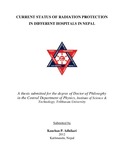Please use this identifier to cite or link to this item:
http://archive.nnl.gov.np:8080/handle/123456789/404| Title: | Current status of radiation protection in different hospitals in Nepal |
| Authors: | Adhikari, Kanchan P. |
| Keywords: | Radiation protection Dose Limit Personnel monitoring Workload Quality control |
| Issue Date: | 5-Dec-2017 |
| Abstract: | Nepal has a long history of medical radiology since1923 but unfortunately, we still do not have any Radiation Protection Infrastructure to control the use of ionizing radiations in the various fields. Now, Nepal is a member state of the International Atomic Energy Agency (IAEA) and this will certainly support and speed up the creation of appropriate conditions. The objective of this research was an assessment of the radiation protection in medical uses of ionizing radiation. In fact, due to lack of laws and regulations, radiation survey and quality control are not even recommended in Nepal. Only some hospitals have established some systems, voluntarily. Twenty-eight hospitals with diagnostic radiology facility were chosen for this research study according to patient loads, equipment and working staffs which include forty-six X-ray, ten CT Scan, two Mammogram and two Catheterization Laboratory. Radiation survey was also done in one newly established Nuclear Medicine facility. Radiation surveys were also done at five different radiotherapy centers. In radiotherapy, three Tele-cobalt, two HDR Brachytherapy, three Linear Accelerator and two Simulator were surveyed. Altogether, two hundred and three Radiation workers entertained the questionnaire, out of which forty-one are from the Radiotherapy and hundred and sixty two are from diagnostic radiology. The radiation workers who have participated in the questionnaire represent more than 50% of the radiation workers working in this field in Nepal. Questionnaire for radiation workers were used; radiation dose levels were measured and an inventory of availability of radiation equipment made. A corollary objective of the study was to create awareness in among workers on possible radiation health hazard and risk. It was also deemed important to know the level of understanding of the radiation workers in order to initiate steps towards the establishment of Nepalese laws, regulation and code of radiological practice in this field. Almost all X-ray, CT and Mammogram unit working area were built according to protection criteria and hence found safe. Radiation survey at Nuclear Medicine shows radiation levels are within safe limit. The measurement which we have done, are very useful only for a particular situation (time of high workload, accidental situation, release of radioisotope etc. Radiation dose level in five Radiotherapy centers shows that all the reference points are within safe limit. Only 34.5% of the personnel are using TLD for personnel monitoring, which comes mostly from the hospitals having radiotherapy facilities. The result shows that around 65% of the personnel are not monitored for radiation. Z test for proportion against hypothesized value of 75% was done in different situations, we get p values is under 0.03 which is quite satisfactory. The p value is within the hypothesis value. There is no quality control program in any of the surveyed hospitals except radiotherapy facilities. Before any new or sophisticated radiological equipment or building is used clinically for the first time, a radiation survey, an acceptance test and quality control must be carried out to the equipment and facility no matter how urgent the clinical needs. Arrangements must be made for the survey well in advance and the time allowed for its completion so that defects can be corrected before staff and patients are exposed to any level of radiation hazard. There is a great need of rules/regulations and regulatory board in this field. The basic radiation protection principles of Justification and Optimization should be taken into consideration in this period of rapid increase of investigation following the availability of new equipment. |
| Description: | A thesis submitted for the degree of Doctor of Philosophy in the Central Department of Physics, Institute of Science & Technology, Tribhuvan University, Nepal, 2012. |
| URI: | http://103.69.125.248:8080/xmlui/handle/123456789/404 |
| Appears in Collections: | 600 Technology (Applied sciences) |
Files in This Item:
| File | Description | Size | Format | |
|---|---|---|---|---|
| CURRENT STATUS OF RADIATION PROTECTION AT DIFFERENT HOSPITALS IN NEPAL Kanchan P Adhikari.pdf | 5.61 MB | Adobe PDF |  View/Open |
Items in DSpace are protected by copyright, with all rights reserved, unless otherwise indicated.